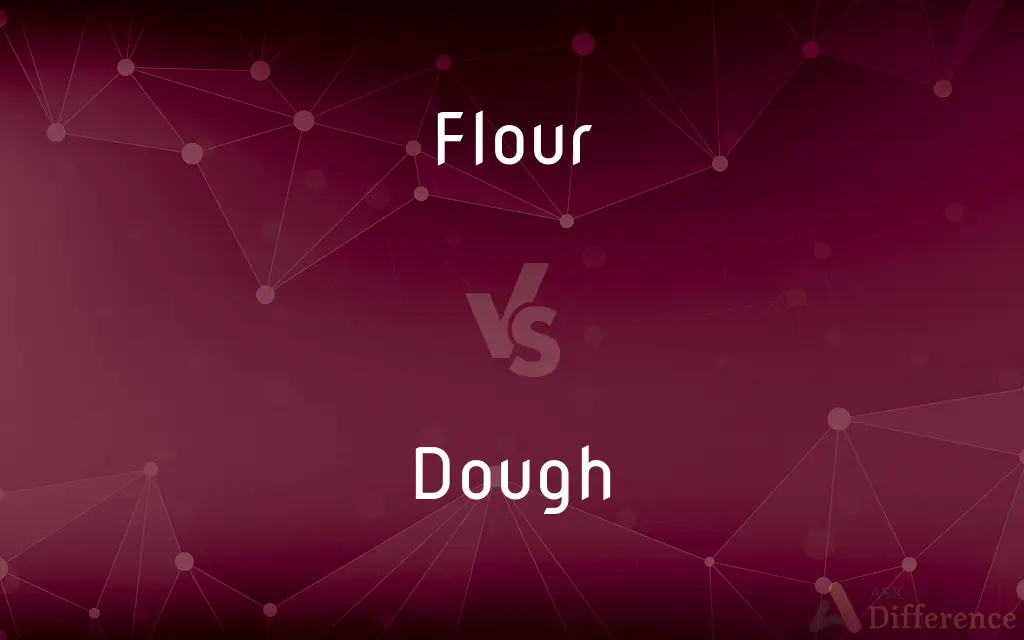Flour vs. Dough — What's the Difference?
By Fiza Rafique & Maham Liaqat — Updated on April 24, 2024
Flour, a powdery ingredient made from ground grains, is essential for baking and cooking; dough, a mixture of flour and liquid, is the base for breads and pastries.

Difference Between Flour and Dough
Table of Contents
ADVERTISEMENT
Key Differences
Flour is a fine powder obtained from grinding grains, nuts, seeds, or roots, essential for many culinary tasks, while dough is a pliable mixture made from combining flour with water and often includes yeast or other leavening agents to prepare various baked goods.
Flour is the basis of many forms of dough, but it also has other uses in cooking, such as thickening soups or coating foods before frying, whereas dough is specifically used as the base for baking bread, pastries, and other similar items.
Flour comes in various types, such as wheat, almond, or coconut, each with different properties suitable for specific recipes; dough recipes vary primarily in terms of the type of flour used, the proportion of ingredients, and additives like sugar, salt, or fats.
In the industrial context, flour is produced in large mills through a refining process that may involve bleaching and enriching, whereas dough is typically mixed in bakeries or homes shortly before baking.
Handling flour requires care to prevent a mess or respiratory issues due to its powdery nature, whereas handling dough involves kneading and shaping, which can be labor-intensive but crucial for texture development.
ADVERTISEMENT
Comparison Chart
Composition
Ground grains, nuts, or seeds
Flour mixed with water and other ingredients
Primary Use
Baking, thickening, coating
Baking breads, pastries
Varieties
Wheat, almond, coconut, etc.
Yeast dough, sourdough, etc.
Preparation Process
Ground and refined
Mixed and kneaded
Physical Characteristics
Fine, dry powder
Pliable, sticky mixture
Compare with Definitions
Flour
A gluten-free alternative made from finely ground almonds.
Almond flour is excellent for macarons.
Dough
A simple dough of flour, eggs, and salt, rolled thin and cut into shapes.
Fresh pasta dough yields superior taste and texture.
Flour
A low-carb, fibrous flour made from dried coconut.
Coconut flour is popular in keto diet recipes.
Dough
A yeast-leavened flour mixture spread into thin rounds for making pizzas.
He tossed the pizza dough expertly before adding toppings.
Flour
Wheat flour mixed with leavening agents.
Self-rising flour speeds up the baking process.
Dough
A basic mixture of flour, water, yeast, and salt, left to rise before baking.
The bread dough doubled in size after an hour.
Flour
Finely milled wheat flour with a lower protein content, ideal for soft-textured cakes.
Cake flour gives the sponge a light, airy texture.
Dough
A dough made from naturally fermented flour and water, known for its tangy flavor.
The sourdough had a distinctively tangy crust.
Flour
Ground wheat used as a base for bread and cakes.
She sifted the wheat flour before making the cake.
Dough
A sweet dough made from flour, sugar, butter, and eggs, used for baking cookies.
She scooped the cookie dough onto the baking sheet.
Flour
Flour is a powder made by grinding raw grains, roots, beans, nuts, or seeds. Flours are used to make many different foods.
Dough
Dough is a thick, malleable, sometimes elastic paste made out of any grains, leguminous or chestnut crops. Dough is typically made by mixing flour with a small amount of water and/or other liquid, and sometimes includes yeast or other leavening agents as well as other ingredients such as various fats or flavorings.
Flour
A powder obtained by grinding grain, typically wheat, and used to make bread, cakes, and pastry.
Dough
A thick, malleable mixture of flour and liquid, used for baking into bread or pastry
Add water to the flour and mix to a manageable dough
Flour
Sprinkle (something, especially a work surface or cooking utensil) with a thin layer of flour.
Dough
Money
Lots of dough
Flour
Grind (grain) into flour.
Dough
A soft, thick mixture of dry ingredients, such as flour or meal, and liquid, such as water, that is kneaded, shaped, and baked, especially as bread or pastry.
Flour
A fine, powdery foodstuff obtained by grinding and sifting the meal of a grain, especially wheat, used chiefly in baking.
Dough
A pasty mass similar to this mixture.
Flour
Any of various similar finely ground or powdered foodstuffs, as of cassava, chickpeas, or bananas.
Dough
(Slang) Money.
Flour
A soft, fine powder.
Dough
A thick, malleable substance made by mixing flour with other ingredients such as water, eggs, and/or butter, that is made into a particular form and then baked.
Pizza dough is very stretchy.
Flour
To cover or coat with flour.
Dough
Money.
His mortgage payments left him short on dough.
Flour
To make into flour.
Dough
(transitive) To make into dough.
The flour was doughed with a suitable quantity of water.
Flour
Powder obtained by grinding or milling cereal grains, especially wheat, or other foodstuffs such as soybeans and potatoes, and used to bake bread, cakes, and pastry.
Dough
Paste of bread; a soft mass of moistened flour or meal, kneaded or unkneaded, but not yet baked; as, to knead dough.
Flour
The food made by grinding and bolting cleaned wheat (not durum or red durum) until it meets specified levels of fineness, dryness, and freedom from bran and germ, also containing any of certain enzymes, ascorbic acid, and certain bleaching agents.
Dough
Anything of the consistency of such paste.
Flour
Powder of other material.
Wood flour, produced by sanding wood
Mustard flour
Dough
A flour mixture stiff enough to knead or roll
Flour
Obsolete form of flower
Dough
Informal terms for money
Flour
(transitive) To apply flour to something; to cover with flour.
Flour
(transitive) To reduce to flour.
Flour
(intransitive) To break up into fine globules of mercury in the amalgamation process.
Flour
The finely ground meal of wheat, or of any other grain; especially, the finer part of meal separated by bolting; hence, the fine and soft powder of any substance; as, flour of emery; flour of mustard.
Flour
To grind and bolt; to convert into flour; as, to flour wheat.
Flour
To sprinkle with flour.
Flour
Fine powdery foodstuff obtained by grinding and sifting the meal of a cereal grain
Flour
Cover with flour;
Flour fish or meat before frying it
Flour
Convert grain into flour
Common Curiosities
Is dough only used for making bread?
No, dough is also used for making pastries, pizzas, and other baked goods.
Can flour be used directly to make bread?
No, flour must be mixed with water, yeast, and other ingredients to make dough, which is then baked into bread.
What is flour primarily used for?
Flour is primarily used as a base ingredient in baking, thickening sauces, and coating foods.
How is dough made from flour?
Dough is made by mixing flour with water and other ingredients like yeast, sugar, and fats.
What are the differences between bread dough and pizza dough?
Bread dough is typically softer and requires a longer rising time, whereas pizza dough is firmer and often used immediately after a short rise.
How can dough be stored for later use?
Dough can be refrigerated or frozen for later use, though fresh preparation is often preferred for best results.
What types of flour are commonly used in baking?
Common types include wheat, almond, and coconut flour.
What are the health considerations with flour?
Flour can cause respiratory issues if inhaled and may need to be avoided or substituted in gluten-free diets.
How does the type of flour affect the dough's properties?
Different types of flour affect the texture, elasticity, and flavor of the dough.
What is the role of kneading in dough preparation?
Kneading develops gluten, which gives bread its structure and texture.
What is gluten-free flour?
Gluten-free flour is made from grains or seeds that do not contain gluten, like rice or almond.
How long should dough be kneaded?
Typically, dough should be kneaded for about 10 to 12 minutes by hand or 8 minutes by mixer.
What precautions should be taken when handling flour?
Care should be taken to avoid inhaling flour dust, and it should be stored in a dry place to prevent clumping and spoilage.
How does sourdough differ from other types of dough?
Sourdough is made from a naturally fermenting culture of flour and water, giving it a unique flavor and texture.
What is the importance of yeast in dough?
Yeast helps the dough rise and adds to the bread's flavor and texture.
Share Your Discovery

Previous Comparison
Lesson vs. Moral
Next Comparison
Echopraxia vs. EcholaliaAuthor Spotlight
Written by
Fiza RafiqueFiza Rafique is a skilled content writer at AskDifference.com, where she meticulously refines and enhances written pieces. Drawing from her vast editorial expertise, Fiza ensures clarity, accuracy, and precision in every article. Passionate about language, she continually seeks to elevate the quality of content for readers worldwide.
Co-written by
Maham Liaqat














































